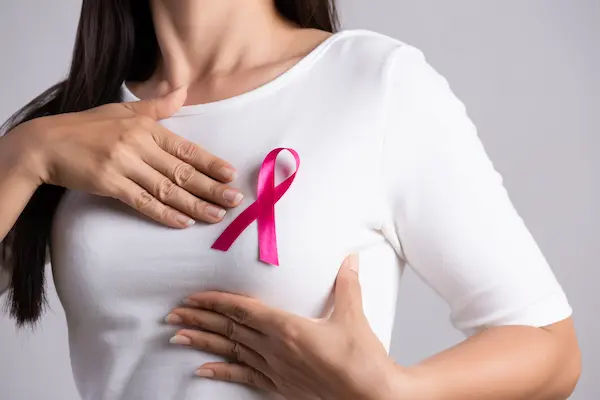Breast Cancer Risk Assessment
Learn about the key factors influencing breast cancer risk, the importance of early detection, and effective risk assessment tools. Discover preventive strategies and the vital role healthcare providers play in supporting breast cancer patients.

Written by
Last updated on 3rd Jul, 2025
Breast cancer is the uncontrolled growth of abnormal cells in the milk ducts or lobules of the breast. The early stage of the cancer is usually non-invasive and can be treated, but as time passes, it can grow. This growth leads to invasive cancer and forms tumours that spread into surrounding tissues.
Therefore, identifying breast tumours at an early stage and assessing their risk should take priority. This article will explore the importance of early detection and key risk factors that influence the condition. It will also discuss some tools that can help assess the condition efficiently.
Factors Influencing Breast Cancer Risk
Breast cancer risk is influenced by several factors. Often, these factors work together. Some key factors include:
Age: The risk of breast cancer increases with age. Most cases are diagnosed after age 50.
Genetic Mutations: Changes in certain inherited genes, such as BRCA1 and BRCA2, raise the risk of breast and ovarian cancer.
Reproductive History: Starting periods before age 12 or reaching menopause after 55 increases hormone exposure, raising the risk.
Dense Breasts: Women with dense breast tissue are at a higher risk. Dense tissue can also make it harder to detect tumours on a mammogram.
Personal History of Breast Issues: Women who’ve had breast cancer are more likely to develop it again. Certain non-cancerous conditions, like atypical ductal hyperplasia or lobular carcinoma in situ, also increase risk.
Family History: Having close family members with breast or ovarian cancer increases the risk, particularly if a mother, sister, or daughter was diagnosed at a young age or if male relatives have had breast cancer.
Genetic Testing for Breast Cancer
The BRCA gene test checks for DNA changes that raise the risk of breast and ovarian cancer. A sample of blood or saliva is used to detect these changes. DNA, which carries genetic instructions, can have harmful changes—called mutations or variants—that increase cancer risk.
Genetic testing focuses on mutations in the BRCA1 and BRCA2 genes. Sometimes, a multigene panel is recommended by a genetic counsellor. This test looks for mutations in multiple genes, including BRCA1 and BRCA2, all at once.
Risk Assessment Tools
Several tools help assess an individual's risk of developing breast cancer. Two commonly used models are:
1. The Gail Model (Breast Cancer Risk Assessment Tool)
This tool estimates a woman’s risk of developing breast cancer over the next five years or up to age 90. It considers personal medical history, reproductive history, and family history of breast cancer. Factors like age, age at first menstrual period, age at first live birth, family history, race/ethnicity, and BRCA1 or BRCA2 gene mutations are included in the assessment.
2. The Tyrer-Cuzick Model
This model estimates breast cancer risk using information about BRCA1/2 mutation carrier status and other factors. It considers age at menarche, parity, age at first childbirth, age at menopause, atypical hyperplasia, lobular carcinoma in situ, height, and body mass index.
High-Risk Populations
Some people face a higher risk of developing breast cancer, but this does not mean they will definitely get the disease. It simply increases the likelihood.
1. Family History of Breast Cancer
Individuals with a family history of breast cancer may have a higher risk. Having a mother, sister, or daughter diagnosed with breast cancer increases the chances, especially if multiple relatives are affected or if a relative was diagnosed before age 50. However, most women with a family history of breast cancer will not develop it.
2. Individuals with Previous Breast Abnormalities
Women with dense breast tissue are at higher risk. Dense breasts have less fat and more connective tissue and cells, making it harder to detect tumours. Additionally, benign breast conditions can also raise the risk. These include:
Non-proliferative changes (no increased cell growth)
Proliferative changes without atypia (increased cell growth but no abnormal cells)
Proliferative changes with atypia (abnormal cell growth, such as atypical hyperplasia)
Steps in Risk Assessment
A breast cancer risk assessment involves reviewing a person's family and personal history and using a risk tool to estimate their risk. This process helps guide decisions about genetic testing and screening recommendations.
Step 1: Review Family History
The first step is to assess the family history of breast and other cancers. This helps identify inherited risks and determine if further genetic testing is needed.
Step 2: Review Personal History
The next step involves examining the individual’s personal history. Key factors include:
Demographics: Age and ethnicity
Hormonal and reproductive history: Age at menarche and menopause, use of hormone therapy, parity, and age at first childbirth
Breast density: High-density tissue increases risk
Personal breast history: Any prior breast conditions or abnormalities
Step 3: Use a Risk-Prediction Model
Finally, an appropriate risk-prediction tool is chosen to estimate the individual’s breast cancer risk. Using the results, healthcare providers can offer personalised advice on when to start screening, the frequency and type of screening, and whether risk-reducing medications are necessary.
Preventive Strategies for High-Risk Groups
Here are a few strategies to prevent breast cancer-
Maintain a healthy weight: Maintaining a healthy weight is crucial for overall health. Being overweight, especially after menopause, can raise the risk of breast cancer and several other types of cancer.
Stay physically active: Regular physical activity can improve mood, boost energy, and help control weight. It also reduces the risk of many diseases, including breast cancer. Aim for at least 30 minutes of exercise daily. Even small amounts of activity are better than none.
Eat well and limit alcohol: A healthy diet with plenty of fruits and vegetables can lower breast cancer risk. Limiting alcohol is important since even small amounts can increase risk. For the best results, avoiding alcohol altogether is the healthiest choice.
Quit smoking: Smoking increases the risk of at least 15 cancers, including breast cancer. Quitting at any age offers significant health benefits.
Breastfeed when possible: Breastfeeding for a total of one year or more, across all children, can reduce breast cancer risk. It also provides many health benefits for the child.
Be cautious with birth control pills: Birth control pills carry risks and benefits. While they may slightly raise breast cancer risk during use, this risk drops after stopping them. However, they offer benefits like reducing ovarian, colon, and uterine cancer risks. Discuss concerns with a healthcare provider to make an informed decision.
Limitations and Challenges in Risk Assessment
Risk assessment for breast cancer helps identify individuals at higher risk, allowing for early interventions. However, it also faces several challenges and limitations, including:
Variability in Risk Models
Challenge: Different models, such as the Gail and Tyrer-Cuzick models, rely on varying data and assumptions, which can lead to inconsistent results.
Limitation: Without a universal standard, comparing predictions across models becomes difficult.
Psychological Impact
Challenge: Being identified as high-risk can cause anxiety and stress, especially when individuals are unsure about their preventive options.
Limitation: Emotional distress may discourage some from pursuing further screenings or preventive measures.
Environmental and Lifestyle Factors
Challenge: Factors like diet, physical activity, and environmental exposures are difficult to measure accurately.
Limitation: These are often underestimated or excluded, reducing the reliability of risk models.
Limitations of Imaging and Biomarkers
Challenge: Imaging tools, like mammograms, and biomarkers may not always provide clear results, especially for those with dense breast tissue.
Limitation: False positives or negatives can complicate decisions about prevention and treatment.
The Role of Healthcare Providers
Healthcare providers play a crucial role in breast cancer treatment by offering expertise, emotional support, and comprehensive care. They help with early detection through screenings and imaging, while pathologists confirm the diagnosis.
Here’s how different healthcare professionals offer assistance:
Oncologists create personalised treatment plans, which may include surgery, chemotherapy, radiation, or hormone therapy, often working within multidisciplinary teams.
Nurses offer care throughout treatment, educate patients, and manage side effects.
Specialists like physical and occupational therapists assist with recovery and rehabilitation.
Social workers and psychologists help with emotional and practical challenges, while palliative care teams focus on comfort in advanced stages.
Providers also support patients in survivorship, monitoring for recurrence and promoting long-term well-being.
Conclusion
Early detection and risk assessment play a vital role in managing breast cancer. Understanding the factors that influence risk, along with using effective tools for assessment, can lead to timely interventions and better outcomes. Although there are limitations and challenges, healthcare providers are essential in offering support, treatment, and guidance to those at risk.
By focusing on prevention and regular screenings, individuals can take control of their health and reduce the likelihood of breast cancer.
Consult Top Gynaecological Oncologist
Consult Top Gynaecological Oncologist

Dr Bhawna Garg
Gynaecological Oncologist
26 Years • MBBS, MS, (PGI MS ROHTAK) FELLOWSHIP GYNECOLOGY ONCOLOGY, (CANCER INSTITUTE CHENNAI)
Delhi
Apollo Hospitals Indraprastha, Delhi

Dr. Rupam Manna
Radiation Specialist Oncologist
7 Years • MBBS MD(RADIO THERAPY), CCEBDM
Barasat
Diab-Eat-Ease, Barasat

Dr. Revathi S Rajan
Obstetrician and Gynaecologist
24 Years • MBBS, DGO, DNB.FFMM
Bengaluru
Apollo Clinic, JP nagar, Bengaluru

Dr. Sreeparna Roy
Obstetrician and Gynaecologist
8 Years • MBBS , MS (OBSTETRICS & GYNAECOLOGY), Fellowship in Infertility, Endoscopy & Ultrasonography), Fellowship in Laparoscopy & Hysteroscopy,DRM
Kolkata
Dr Utsa Basu Clinic, Kolkata
Dr. B Shravanthi Reddy
Radiation Specialist Oncologist
8 Years • MBBS, DNB(Radiation Oncology)
Manikonda Jagir
Apollo Clinic, Manikonda, Manikonda Jagir




